Swachh Survekshan 2024-25 Awards | 18 Jul 2025
Why in News?
The President of India conferred Swachh Survekshan Awards 2024-25 (9th edition) hosted by the Ministry of Housing and Urban Affairs (MoHUA) in New Delhi.
What are the Key Highlights of Swachh Survekshan 2024-25 Awards?
- Revamped Format & Super Swachh League: To ensure a level playing field and acknowledge consistent top performers like Indore (ranked No. 1 for 7 consecutive years), MoHUA introduced a new category- Super Swachh League (SSL) Cities.
- These SSL cities were excluded from regular rankings to promote fairness and encourage emerging cities.
- City Classification Based on Population: For the first time, city classification based on population was introduced, enabling fair comparison and targeted improvement across Urban Local Bodies (ULBs). Cities were ranked in 5 categories:
- Very Small Cities (< 20,000)
- Small Cities (20,000 – 50,000)
- Medium Cities (50,000 – 3 lakh)
- Big Cities (3 – 10 lakh)
- Million Plus Cities (> 10 lakh)
- Special Awards:
- Recognition for Special Initiative of Swachh Mahakumbh 2025: Prayagraj (for waste management during the Mahakumbh 2025)
- Cleanest Ganga Town: Prayagraj
- Safaimitra Surakshit Shehar Awards: Visakhapatnam, Jabalpur, and Gorakhpur recognized for ensuring the safety and dignity of sanitation workers.
- Cleanest Cantonment Board: Secunderabad Cantonment
- Promising Swachh Shehar of State: 35 cities across 33 States/UTs were recognized as “Promising Swachh Shehar” for their notable progress in urban sanitation.
- Key cities included Rajahmundry, Patna, Guwahati, Pimpri Chinchwad, Agra, and Bhubaneswar.
What is Swachh Survekshan under Swachh Bharat Mission (SBM)?
Swachh Survekshan
- About: Swachh Survekshan, conducted by the MoHUA since 2016, is the world’s largest urban sanitation and cleanliness survey under Swachh Bharat Mission–Urban (SBM-U).
- Swachh Survekshan Awards are annual rankings and recognitions given to cities and urban local bodies (ULBs) under the Swachh Survekshan.
- Objective: It aims to foster citizen participation, generate awareness on sanitation, and promote competitive federalism through performance benchmarking.
- Key Features:
- Launched with just 73 cities, it has expanded to cover 4,589 Urban Local Bodies (ULBs) in the 2024–25 edition.
- Cities are evaluated based on parameters such as waste segregation, processing, sanitation in public spaces, and citizen feedback.
- The 9th edition was conducted from April 2024 to March 2025.
- Swachh Survekshan 2025: Under the revamped framework of Swachh Survekshan 2025, indicators have been simplified and restructured into 10 comprehensive sections, with a special focus on tourist and high-footfall areas and the sanitation of public spaces.
- The annual theme for 2025 is “Reduce, Reuse, Recycle (3R)”, promoting circular economy principles in line with the Jaipur Declaration adopted at the 12th Regional 3R and Circular Economy Forum (March 2025).
- Additionally, new indicators have been introduced for Project Grounding and City Transport Unit (CTU) transformation, along with the launch of school-level assessments to inculcate Swachhta values among the youth.
Swachh Bharat Mission (SBM)
- About: Launched on 2nd October 2014, the SBM is a nationwide cleanliness drive, divided into SBM-Gramin (under the Ministry of Jal Shakti) and SBM-Urban (under MoHUA), with funding support from the Swachh Bharat Kosh for CSR and philanthropic contributions.
- Objective: The mission’s initial goal was to make India Open Defecation Free (ODF) by 2nd October 2019, through large-scale construction of toilets and behavioral change campaigns.
- Phase-II (SBM-Gramin) was launched in 2020–21 with the aim to achieve ODF Plus status by 2024–25 through solid and liquid waste management in rural areas.
- SBM-Urban 2.0, introduced in 2021, focuses on garbage-free cities, faecal sludge and plastic waste management, greywater treatment, and capacity building to sustain urban sanitation outcomes.
UPSC Civil Services Examination, Previous Year Question (PYQ)
Q. As per the Solid Waste Management Rules, 2016 in India, which one of the following statements is correct? (2019)
(a) Waste generator has to segregate waste into five categories.
(b) The Rules are applicable to notified urban local bodies, notified towns and all industrial townships only
(c) The Rules provide for exact and elaborate criteria for the identification of sites for landfills and waste processing facilities.
(d) It is mandatory on the part of the waste generator that the waste generated in one district cannot be moved to another district.
Ans: (c)


